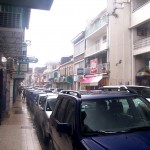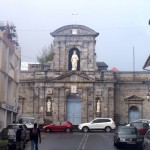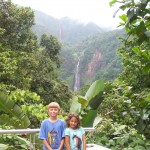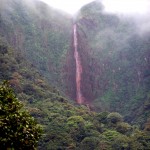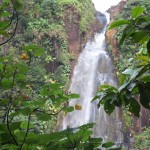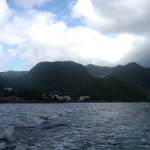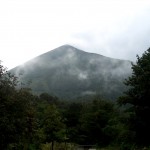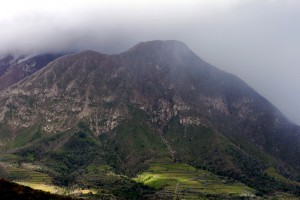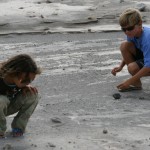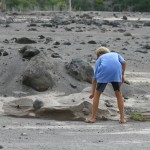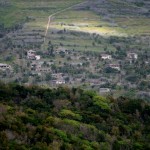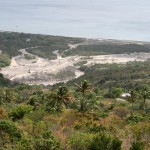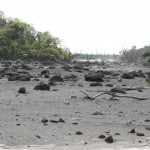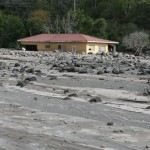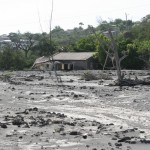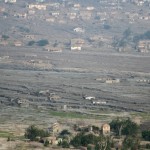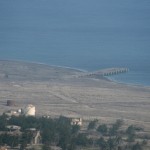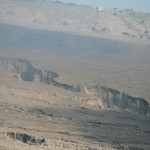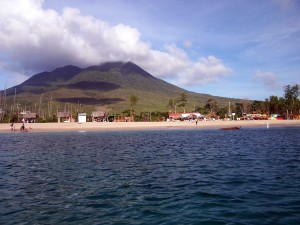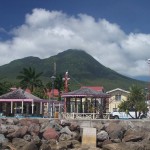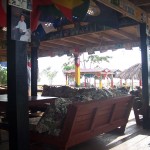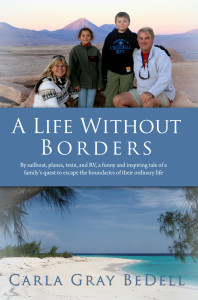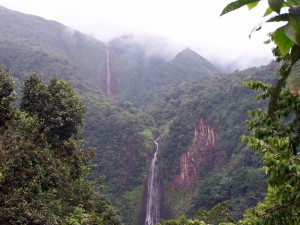 Yellow-green, shamrock, mountain meadow, tropical rain forest, sea green, granny smith apple green, Caribbean green, forest, fern, these are all colors of green found in a box of crayola crayons, and these are a few of the colors that barely begin to describe the multi shades of green found in the Guadeloupe countryside. Simply beautiful.
Yellow-green, shamrock, mountain meadow, tropical rain forest, sea green, granny smith apple green, Caribbean green, forest, fern, these are all colors of green found in a box of crayola crayons, and these are a few of the colors that barely begin to describe the multi shades of green found in the Guadeloupe countryside. Simply beautiful.
We left Montserrat on Sunday and headed straight to Basse Terre. There we anchored just outside the marina, close to shore, and at the base of the beautiful mountains and former volcano. We had any easy check in on Monday, no charge. Guadeloupe is all french, surprisingly for a big city like Basse Terre, there is little english spoken. Not to worry. Dan and I both had high school french (a long time ago) and we were armed with our trusty Cruiser’s Guide to French book. Trying to find an ATM was tough. Guadeloupe takes the EURO and we had none. The customs agent said we could try the post office and people did seem to be standing in line to get cash. I asked a woman in front of me if I could get cash and she didn’t speak english. Luckily the woman in front of her spoke some english. She told me she thought I could get cash here but she wasn’t sure. She said that instead of waiting in line, I could cut in line, and ask the lady behind the counter. That would have been a great idea if I actually knew how to say what I wanted. Instead I decided to remain in line and practice what I wanted to say in French. Of course trying to put the sentence I want together involves flipping back and forth between several pages, all while Dan tries to make changes in the verbage.
“Ok, ask her if you can get money,” Dan says.
Alright. I start to look that up. I practice. “C’est bien la queue pour le distributeur de billets?” (is this the line for the ATM machine).
“How much do you think we should get out?” Dan asks.
“I don’t know.”
“How about one hundred?”
One hundred sounds good. I flip through the book to find one hundred, meanwhile I try to keep my finger on the line I wanted to say. I can’t find it.
“Excuse me,” I say to the lady in front of me who speaks some english. “How do I say 100?”
“Cent.” (Sahn)
“Merci beaucoup.” I reply. I start practicing again. “Je voudrais cent euro, s’il vous plait?” (I want to get 100 euros please)
“Maybe that’s not enough,” Dan interupts me. “How about 150?”
I struggle with the pages again trying to find 150. “I can’t find 150.”
“Ok, 100 is probably enough anyway.” Alright. I keep practicing. He interupts again.
“200. Do you think 200 would be better?”
I struggle to find 200. “Je voudrais deaux cents euros s’il vous plait?” I repeat it softly several times. The woman in front of me turns and smiles at me. Actually the whole line has heard me practicing. I really want to be able to say this smoothly.
“Je voudrais deaux cents euros s’il vous plait? Je voudrain deaux euros s’il vous plait?”
“You know, maybe 250 would be better.”
I am getting mad. “I don’t know how to say 250.”
“Well we may need 250.”
“Fine. You look it up.”
He just stares at me. “Ok. You know 200 is probably ok. I was just thinking…”
“Enough.” I nearly shout at Dan. “Do you know how hard this is without you changing your mind every second?”
Finally it’s my turn and I ask for 200 euros (nearly flawlessly I might add) and she answers something back in French which I interpret to mean they don’t take my card. Great. That was a wasted effort. We walked back to our dinghy and reluctantly headed back to the boat. Later that afternoon, we took the dingy further down to Basse Terreand left it tied to the ferry dock as we searched for an ATM. As we were going it poured down rain, and within moments we were soaked. From the guidebook we had a general idea where the ATM was, but we weren’t sure where we were at that point. I looked up how to say “Where is the ATM?.” (Ou est la banque?”) Apparently I pronounced it well as the lady I spoke to knew exactly what I said and started rattling off in French. Now I can pronounce in French, I can read French, but I am not so good at hearing french. We did a lot of hand motions and she did too and somehow with her directions, Dan was able to find the bank. Amazing! We got our money, bought a few bananas from a vendor (bananas are the number one export) and headed back to our boat. With our new money we were now able to hit the bakery close to the marina. Very good. I was also able to do some very expensive laundry. Later that evening I was even able to use my limited French to buy us some fresh tuna from the fisherman at the marina. It was very good!
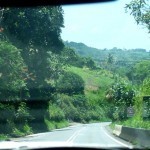 We needed a part for the engine, and Pointe-A-Pitre is well known for its yacht services so we rented a car. It wasn’t until I was behind the wheel that we realized it’s a manual transmission. I haven’t driven a stick shift in at least 14 years. Luckily it came back to me and we headed out for an adventure in the countryside. What a beautiful country. The greens just pop. The road wound through palm trees, banana plantations, up and down steep mountains, around sharp curves that skated above cliffs leading to the ocean below. Wonderful. There was something better to see around every corner. It took us about an hour to get to our destination, and when we got there, the marine store was closed for lunch. So we headed for lunch ourselves. At the restaurant we ran into Patrick and Sylvie, our french friends we met in Montserrat. They were on their way to the airport to pick up a friend. Sylvie told us that if there is one thing you do in Guadeloupe, make sure you stop at a waterfall. She told us there was one just off the road on the way back. Luckily the marine store had the part we needed. On to the waterfall.
We needed a part for the engine, and Pointe-A-Pitre is well known for its yacht services so we rented a car. It wasn’t until I was behind the wheel that we realized it’s a manual transmission. I haven’t driven a stick shift in at least 14 years. Luckily it came back to me and we headed out for an adventure in the countryside. What a beautiful country. The greens just pop. The road wound through palm trees, banana plantations, up and down steep mountains, around sharp curves that skated above cliffs leading to the ocean below. Wonderful. There was something better to see around every corner. It took us about an hour to get to our destination, and when we got there, the marine store was closed for lunch. So we headed for lunch ourselves. At the restaurant we ran into Patrick and Sylvie, our french friends we met in Montserrat. They were on their way to the airport to pick up a friend. Sylvie told us that if there is one thing you do in Guadeloupe, make sure you stop at a waterfall. She told us there was one just off the road on the way back. Luckily the marine store had the part we needed. On to the waterfall.
The Chutes Du Carbet is located in a national park, a 20 minute drive off the main highway, on winding roads and through small towns. It was an easy drive, even if we seemed to just go up and up. At the end of the road is the car park, and from here it is a 30 minute walk to the first falls, and about an hour to the second. Since it was already 4:00pm we settled on the first one. It was an easy walk down steps, which we knew we would curse on the way back. The view of the waterfall at the end of the trail was impressive. But we found out back at the carpark, you actually had a good view of both waterfalls. The second waterfall is higher up and flows red, reflecting the volcano it comes from. It’s a very nice park and well worth the trip if you are in Guadeloupe.
On Wednesday, Makai and Salida were coming around the bend and we decided to up anchor and join them on the way to the Saintes. As we hauled anchor, a huge fishing net wrapped around our chain, and we couldn’ t get the anchor up. Thank goodness our friends were there!! Craig and Liz on Salida had a Hookah. It took Dan and Craig over an hour, breathing through the hookah, to cut through the fishing net. I don’t know what we would have done without them!!
Guadeloupe is beautiful and charming. We loved the food, the adventure of trying to speak another language, the picturesque countryside. We wish we could have stayed longer. It will go down as one of our favorite islands.

